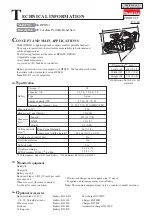
HX SERIES
V0212
19
–
English
–
Deutsch
Saw guide
(fig. 10)
1 The saw guide is mounted on the cross-cut fence by means of 2 quick release handles (3).
2 This saw guide can be moved along the scale bar and can be secured by pushing the locking
handle (2) down.
3 The saw guide has T-grooves on 2 sides, which allows a high or low position.
4 Adjust the height of the saw blade, in accordance with the thickness of the piece.
5 If possible, mount the guide, according to the height of the piece, vertically or horizontally and
pull it back to the height of the riving knife.
6 Lock the guide with the handles (3)
7 The wanted cut can be read of the scale bar
8 For small cuts and cuts with tilted saw blade, the saw guide can be tilted to the low position thus
avoiding sawing the saw guide, when making thin cuts.
WARNING:
for narrow cuts along the saw fence always use a push stick!
Fig.10
Sliding table
(fig. 11)
The machine is delivered with the sliding table mounted onto it. For a good adjustment and functioning
of the sliding table, it is necessary that the machine is evenly placed in both directions by means of a
level. All adjustments and adaptations of the sliding table have been made by the factory.
To create a smooth movement of the wood or the panel, the sliding table is set at +/- 0.2 mm above de
cast iron saw table.
The sliding table can be locked in one position along the whole length. This is necessary when, for
example, sawing lengthways with the parallel fence.
The bolt is situated on the side of the sliding table (fig. 11.1). Pull the bolt forward and click it in the
opening at the side of the sliding table. To unlock it, pull the bolt backwards and turn it 180°. Two
rubber stops on the lower beam of the sliding table stop the course of the sliding table. When multiple
movements back and forwards are repeated, it is possible that the ball bearing moves slightly. This will
cause some resistance when pushing the sliding table.
This can also occur if the total course of the sliding table is shortened. With a few short pushes, with
the purpose of reaching the end of the course, the position of the ball bearing can be improved.
1
2
Summary of Contents for HX TZ
Page 1: ...HX SERIE Manual Betriebsanleitung...
Page 37: ...36 V0212 HX SERIES English Deutsch...
Page 70: ...HX SERIES V0212 69 English Deutsch...
Page 71: ...70 V0212 HX SERIES English Deutsch...
Page 72: ...HX SERIES V0212 71 English Deutsch...
Page 73: ...72 V0212 HX SERIES English Deutsch...
Page 74: ...HX SERIES V0212 73 English Deutsch...
Page 75: ...74 V0212 HX SERIES English Deutsch...
Page 76: ...HX SERIES V0212 75 English Deutsch...
Page 77: ...76 V0212 HX SERIES English Deutsch...
Page 78: ...HX SERIES V0212 77 English Deutsch...
Page 79: ...78 V0212 HX SERIES English Deutsch...
Page 80: ...HX SERIES V0212 79 English Deutsch...
Page 81: ...80 V0212 HX SERIES English Deutsch...
Page 82: ...HX SERIES V0212 81 English Deutsch...
Page 83: ...82 V0212 HX SERIES English Deutsch...
Page 84: ...HX SERIES V0212 83 English Deutsch...
Page 85: ...84 V0212 HX SERIES English Deutsch...
Page 86: ...HX SERIES V0212 85 English Deutsch...
Page 87: ...86 V0212 HX SERIES English Deutsch...
Page 88: ...HX SERIES V0212 87 English Deutsch...
Page 89: ...88 V0212 HX SERIES English Deutsch...
Page 90: ...HX SERIES V0212 89 English Deutsch...
Page 91: ...90 V0212 HX SERIES English Deutsch...
Page 92: ...HX SERIES V0212 91 English Deutsch...
Page 93: ...92 V0212 HX SERIES English Deutsch...
Page 94: ...HX SERIES V0212 93 English Deutsch...
Page 95: ...94 V0212 HX SERIES English Deutsch...
Page 96: ...HX SERIES V0212 95 English Deutsch...
















































